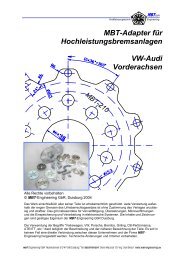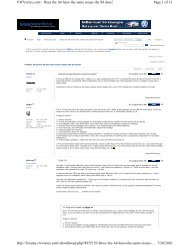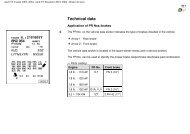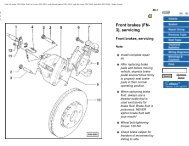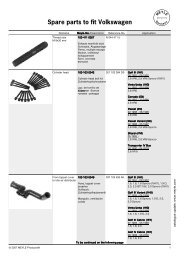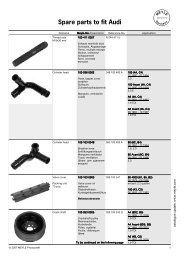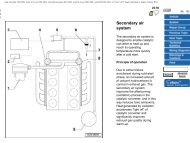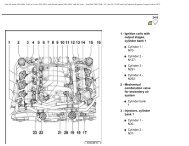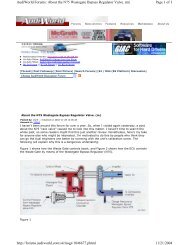VW MKII A2 MK2 Golf Jetta Fox Service Manual - VAGLinks.com
VW MKII A2 MK2 Golf Jetta Fox Service Manual - VAGLinks.com
VW MKII A2 MK2 Golf Jetta Fox Service Manual - VAGLinks.com
Create successful ePaper yourself
Turn your PDF publications into a flip-book with our unique Google optimized e-Paper software.
4A•18 Fuel and exhaust systems - carburettor models<br />
16.7a Throttle valve basic setting showing<br />
rod to hold valve open (arrowed), lock<br />
lever (1) limiting screw (2) and stop (3)<br />
Throttle valve<br />
6 The basic Stage ll throttle valve adjustment<br />
is made during manufacture and should not<br />
require further adjustment. If, for any reason,<br />
the limiting screw has been removed or its<br />
setting altered, readjust it as follows.<br />
7 Open the throttle valve and hold it in<br />
position by inserting a wooden rod or similar<br />
implement between the valve and venturi (see<br />
illustration). Using a rubber band, pretension<br />
the Stage ll throttle valve locking lever then<br />
unscrew the limiting screw to provide a<br />
clearance between the stop and the limiting<br />
screw. Now turn the limiting screw in so that it<br />
is just in contact with the stop. The limiting<br />
screw stop point can be assessed by inserting<br />
a thin piece of paper between the stop and<br />
screw. When the paper starts to get pinched<br />
between the two, the stop point is reached<br />
and from this point, tighten the limiting screw<br />
a further quarter turn then secure it with<br />
locking <strong>com</strong>pound. Close both throttle valves<br />
then measure the locking lever clearances<br />
(see illustration). If the clearances are not as<br />
specified, then bend the levers as necessary.<br />
Slow running and fast idle<br />
8 To check and adjust the slow running<br />
setting, refer to Section 15, paragraphs 7 to<br />
13 inclusive (see illustration).<br />
9 To check and adjust the fast idle<br />
adjustment, first check that the engine is still<br />
at normal operating temperature. The air<br />
16.8 Idle speed adjustment screw and<br />
guide sleeve (A) mixture screw (B)<br />
16.7b Locking lever clearance with throttle<br />
valves closed<br />
Clearance to equal 0.25 to 0.55 mm<br />
(each side)<br />
cleaner must be removed and the other<br />
provisional conditions must apply as for the<br />
slow running adjustment. Plug the air cleaner<br />
temperature control hose.<br />
10 Restart the engine and open the throttle to<br />
give an engine speed of approx. 2500 rpm.<br />
Press down the fast idle cam to its stop then<br />
move the throttle valve back so that the<br />
adjuster screw is on the second highest stop<br />
on the fast idle cam. In this position, the fast<br />
idle speed should be as specified. If the<br />
setting is incorrect, turn the adjustment screw<br />
in the required direction until it is correct (see<br />
illustration). Note that the screw may have a<br />
tamperproof cap fitted.<br />
11 On <strong>com</strong>pletion, unplug the temperature<br />
control connector and refit the air cleaner.<br />
17 Carburettor (1.6 & 1.8 litre<br />
engines) - adjustments 4<br />
Note: Accurate adjustment of the carburettor<br />
is only possible if adjustment of the ignition<br />
timing, dwell angle and spark plug gaps is<br />
correct. Incorrect valve clearances can also<br />
effect carburettor adjustment<br />
Pierburg/Solex 2E2<br />
1 The adjustment procedures for the 2E2<br />
carburettor closely follow those described for<br />
16.10 Fast idle speed adjustment screw (2)<br />
1081 <strong>VW</strong> <strong>Golf</strong> & <strong>Jetta</strong><br />
the 2E3 carburettor. The following checks and<br />
adjustments are additional to, or differ from,<br />
those given.<br />
Part throttle channel heater unit<br />
2 To check this unit, connect a test lamp<br />
between the unit wiring plug and battery<br />
positive terminal. Earth the unit. If the test<br />
bulb fails to light, the unit is defective and<br />
must be renewed.<br />
Choke valve gap (wide open kick)<br />
3 Remove the automatic choke cover and fit<br />
a rubber band to the operating pin, so that the<br />
choke valve is held in the closed position.<br />
4 Hold the primary throttle valve open 45°. To<br />
do this, temporarily insert a 10 mm nut<br />
between the fast idling adjustment screw and<br />
the vacuum unit plunger.<br />
5 Using a twist drill, check that the gap<br />
between the choke valve and carburettor wall<br />
is 6.3 ± 0.3 mm. If not, bend the choke<br />
operating lever as required (see illustration).<br />
6 After making an adjustment, check and<br />
adjust the choke pull-down unit as follows.<br />
Choke pull down unit<br />
7 This unit can be checked in the same<br />
manner as that for the choke pull down unit<br />
on the 2E3 carburettor but note that the<br />
resistance felt must be over the final 5.0 mm<br />
of travel.<br />
8 Note also that from February 1987, the<br />
choke pull-down unit is both temperature and<br />
time-controlled by a thermotime valve. When<br />
the valve is open (starting a cold engine) the<br />
vacuum to the pull-down unit is reduced, and<br />
the choke valve will open by a small amount.<br />
After between one and six seconds<br />
(depending on ambient temperature), the<br />
valve heats up (to approximately 20 to 30°C)<br />
and closes. This allows more vacuum to reach<br />
the pull-down unit and the choke valve will<br />
open by a larger amount. The choke is of<br />
course fully released by the heat of the engine<br />
coolant and the electric heater acting on the<br />
automatic choke bi-metallic spring.<br />
17.5 Checking choke valve gap<br />
Using drill of correct diameter as a gauge<br />
(arrowed)<br />
Note dimension x (10.0 mm)



